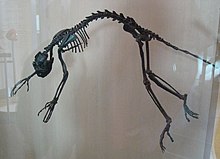| Notharctus | |
|---|---|

| |
| Notharctus tenebrosus | |
| Scientific classification | |
| Domain: | Eukaryota |
| Kingdom: | Animalia |
| Phylum: | Chordata |
| Class: | Mammalia |
| Order: | Primates |
| Suborder: | Strepsirrhini |
| Family: | †Notharctidae |
| Subfamily: | †Notharctinae |
| Genus: | †Notharctus Leidy, 1870 |
| Species | |
| |
| Synonyms | |
Notharctus is a genus of adapiform primate that lived in North America and Europe during the late to middle Eocene.[1]

The body form of Notharctus is similar to that of modern rats. Its fingers were elongated for clamping onto branches, including the development of a thumb. Its spine is flexible and the animal was about 40 centimetres (16 in) in length, excluding the long tail.[2]
There were at least four different Notharctus species.[1] Fossils from at least seven other potential species have also been discovered.[citation needed]

References
[edit]Bibliography
[edit]- Gebo, D.L. (2002). "Adapiformes: Phylogeny and adaptation". In Hartwig, W.C. (ed.). The Primate Fossil Record. Cambridge University Press. ISBN 978-0-521-08141-2. OCLC 47254191.


Well, that’s interesting to know that Psilotum nudum are known as whisk ferns. Psilotum nudum is the commoner species of the two. While the P. flaccidum is a rare species and is found in the tropical islands. Both the species are usually epiphytic in habit and grow upon tree ferns. These species may also be terrestrial and grow in humus or in the crevices of the rocks.
View the detailed Guide of Psilotum nudum: Detailed Study Of Psilotum Nudum (Whisk Fern), Classification, Anatomy, Reproduction